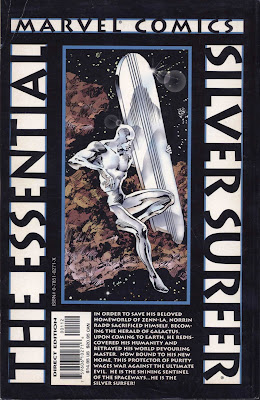Volume 1
Marvel Comics, 1998
Stan Lee wrote all of the issues; the artwork for the first 17 issues was done by John Buscema, with Jack Kirby pencilling issue 18.
This 'Marvel Essentials volume collects, in black and white, all 18 issues of the Silver Surfer comic book series. Like all of the 'Essentials' titles it is designed to provide an affordable packaging of classic Marvel comics.
If you want to read this first series in color, there are two 2010 'Marvel Masterworks' trade paperbacks, both published in 2010, that compile all 18 issues. These two volumes are out of print and copies are on the expensive side.
[Volume 2 of the Essential Silver Surfer covers the character's appearances in Marvel comics throughout the 1980s.]
Issue 1 was an 'origin' story that tells of the intergalactic entity known as Galactus, and his intentions to strip the planet of Zenn-La of all life. Norrin Radd agrees to become his herald, in exchange for a pledge from Galactus to spare Zenn-La.
When the Surfer allies with the Fantastic Four to deny Earth to Galactus, the latter retaliates by imprisoning the Surfer in the Solar System by an invisible ' energy barrier'. Norrin Radd is forever denied the ability to return to Zenn-La and his wife, Shalla Bal.
The succeeding issues of The Silver Surfer are mostly single-issue episodes in which the Surfer confronts 'cosmic' threats to the Earth. A number of supervillains are showcased, including The Stranger and The Overlord. These confrontations often involve 'cosmic' themes, such as time travel and the extinction of all life in the galaxy, that were formerly the province of Marvel heroes such as Thor and the Fantastic Four.
The villain Mephisto makes a number of appearances throughout this inaugural series.
Lee's script called for confrontations between the Surfer and other Marvel superheroes, such as Spider-Man, SHIELD, and the Fantastic Four / Human Torch. Needless to say, the pretext for these battles was always a 'misunderstanding' on the part of both parties.
I remember that, back when a read a few of these issues as a kid in the late 60s and early 70s, I found the Surfer to be the most overwrought character in the Marvel Universe. Re-reading these same issues as an adult, it's abundantly clear. Practically every fourth of fifth page has a least one panel in which Lee's script calls for the Surfer to express Deep Angst over one thing or another......
These showcases of angst come so thick and so fast that they quickly lapse into a tiresome display of self-parody, a phenomenon that Lee probably was completely unaware of.
What saves this 'Essentials' volume, even with its black-and-white reproductions on a lower grade of paper, is the outstanding artwork by John Buscema.
Unfortunately, the readership was never to know whether the 'savagely sensational' incarnation of the character would have increased the comic's circulation, for the series was cancelled at issue 18. Throughout the remainder of the 70s, the hapless Surfer was consigned to appearing as a guest-star in comics like The Defenders.
The verdict ? If you're motivated by nostalgia, a fondness for the Surfer, or by an appreciation of John Buscema's artistic talents, then picking up a copy of 'The Essential Silver Surfer' volume 1 could be worthwhile.














































































